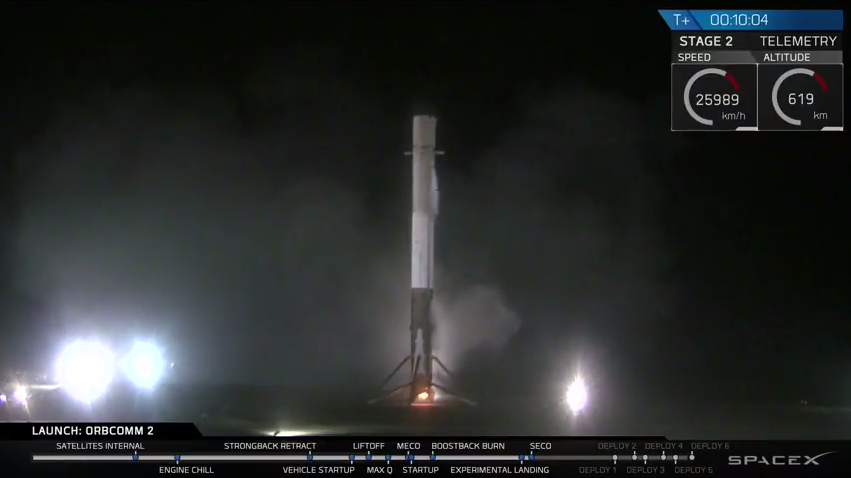
Having suffered the catastrophic loss of a Falcon 9 v1.1 booster during first-stage flight on 28 June—which doomed NASA’s first International Docking Adapter (IDA) and vaporized a critical piece of hardware in support of the agency’s Commercial Crew ambitions—it might be supposed that 2015 has been the worst year in SpaceX’s history. A gradually burgeoning chain of 18 straight launch successes since June 2010 was abruptly broken and the Falcon 9 v1.1 which might have delivered the seventh dedicated Dragon cargo ship toward the International Space Station (ISS) was snuffed out in the rarefied high atmosphere. Never again could SpaceX claim a 100-percent record for the Falcon 9 having delivered each of its primary payloads successfully to orbit.
Yet at 8:29 p.m. EST on Monday, 21 December, after six agonizing months, and a 24-hour postponement from Sunday night, the Hawthorne, Calif.-based launch services provider returned to flight, delivering 11 Orbcomm Generation-2 (OG-2) satellites into low-Earth orbit and opening the doors to a busy 2016. And in spite of recovering from a loss of vehicle incident, SpaceX actually closes out the most troubled 12 months in its history by delivering to orbit its largest number of satellites on a single mission and equaling its own record, set in 2014, for having launched as many as six successful flights within the span of a single calendar year. Moreover, today’s mission represented the maiden voyage of the “Upgraded Falcon 9” booster and its first-stage hardware touched down for the first time on solid ground, alighting on Landing Complex (LC)-1 at Cape Canaveral Air Force Station, Fla. As Canadian astronaut Chris Hadfield commented in the moments after the feat, today’s event “opens a brand new door to space travel.”
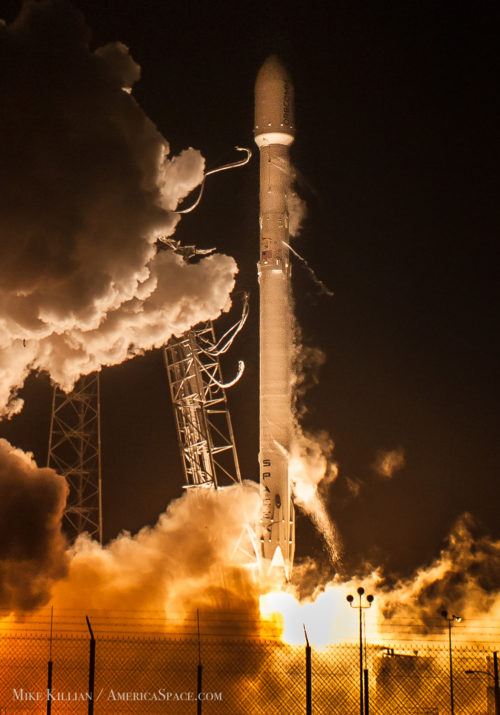
As outlined in a recent AmericaSpace article, the processing campaign to reach this point has been a long one, with SpaceX having announced in September that it anticipated a Return to Flight (RTF) date no sooner than the mid-November timeframe, before eventually slipping until the end of the year. Initial suggestions that the SES-9 communications satellite—destined for insertion into Geostationary Transfer Orbit (GTO)—might ride aboard the RTF mission ultimately proved not to be the case and 11 small OG-2 satellites, destined for a lower-performance injection into low-Earth orbit were instead selected as the primary payload. It is understood that the OG-2 ascent will only require one “burn” of the Falcon 9’s second stage, thus enabling SpaceX to perform a restart test of its Merlin 1D+ Vacuum engine without impacting the requirements of the payload. Successful completion of this milestone would clear an important hurdle for subsequent GTO missions.
In anticipation of a launch in the final days before Christmas, SpaceX raised the 229.6-foot-tall (70-meter) booster—dubbed the “Upgraded Falcon 9” and capable of a 33-percent performance gain over its predecessors, enabled by running the Merlin 1D+ first-stage engines at full thrust, as well as benefiting from other structural enhancements and the “densification” of its liquid oxygen load—to vertical on Wednesday, 16 December, out at Cape Canaveral Air Force Station’s storied Space Launch Complex (SLC)-40. Original plans to perform a brief Static Fire Test of the nine Merlin 1D+ engines on the first stage met with some frustration and did not occur until the evening of Friday, 18 December, following a number of technical difficulties. “Static Fire Test looks good,” tweeted SpaceX CEO Elon Musk late Friday. “Pending data review, will aim to launch Sunday.” This was followed by a satisfactory Launch Readiness Review (LRR) at L-1 day, with Mr. Musk subsequently tweeting that everything was in place for an “Attempted orbital launch and rocket landing at Cape Canaveral.”
Weather conditions at the Cape remained favorable, starkly contrasting with the high winds and rain endured by United Launch Alliance (ULA) during its OA-4 Cygnus launch campaign from neighboring SLC-41, earlier this month. Early Saturday, the 45th Weather Squadron, based at Patrick Air Force Base, explained that a cold front over the Florida Straits would produce “gusty and northerly” winds, although these were expected to slowly weaken and head in an easterly direction as Sunday’s launch window neared. “This offshore wind direction will moderate temperatures,” it was noted, “and create a slight risk for a coastal shower.” All told, a potential violation of the Cumulus Cloud Rule, associated with these showers, was expected to leave a 90-percent probability of acceptable weather at T-0. The situation was expected to deteriorate slightly to 80-percent-favorable in the event of a 24-hour postponement to Monday, due to more unsettled conditions, rain and isolated thunderstorms, which added a possible violation of the Thick Cloud Rule to the mix.
Not until the tail end of last week did the launch time appear to take shape, with speculation from several sources that it would occur within a three-hour “block,” then within a 60-minute period inside that block and even the possibility that it might be an instantaneous window. “The exact window is not yet confirmed,” SpaceX told AmericaSpace last week. “It will be shorter than three hours, but a final window has not yet been confirmed.” However, it ultimately became clear that a 60-second window opening at 8:29 p.m. EST was being targeted for a Sunday launch, followed by 8:33 p.m. in the event of a 24-hour slip to Monday. Coming about three hours after local sunset, this would represent SpaceX’s tenth Falcon 9 launch in the hours of darkness.
As described previously by this site, the “Upgraded Falcon 9,” known informally as the “Full Thrust” (FT) or “Falcon 9 v1.2,” carries the potential to deliver a 33-percent performance “gain” over its predecessor. This has been achieved by running the Merlin 1D+ first-stage engines at full thrust, rather than the approximately 80-percent propulsive yield on earlier missions, as well as benefiting from structural enhancements to the vehicle’s airframe and from the “densification” of its liquid oxygen load.
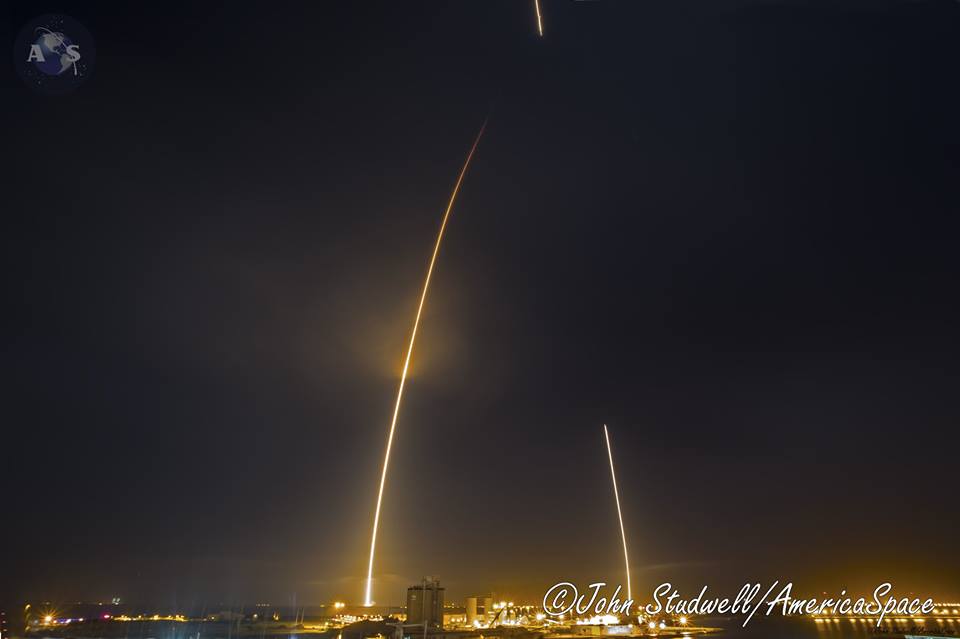
“She looks ready,” tweeted Orbcomm CEO Marc Eisenberg, early Sunday morning. However, Sunday did not prove to be SpaceX’s day. Although there appeared to be no significant issues with the vehicle or the weather, Mr. Musk told his 3.06-million-strong Twitter following that a 24-hour postponement had been called, in order to allow a 10-percent better chance of good conditions for a successful landing of the first stage at the Cape. “Just reviewed mission params [parameters] w SpaceX team,” he tweeted at 3:51 p.m. EST. “Monte Carlo runs show tmrw night has a 10% higher chance of a good landing. Punting 24 hrs.”
Orbcomm later updated the cause for the delay as being also associated with the densified liquid oxygen load aboard the vehicle. “Upon further review of the Static Fire data,” it was explained, “SpaceX has determined that an additional day prior to launch will allow for more analysis and time to further chill the liquid oxygen in preparation for launch.” Monday night’s launch window was later refined to a five-minute period, extending from 8:29 p.m. through 8:34 p.m. EST. “There is only time for one attempt during that window, so SpaceX will go for the optimum time,” noted AmericaSpace’s Launch Tracker. “Should the launch not occur today then the launch teams will stand down until at least 28 December.”
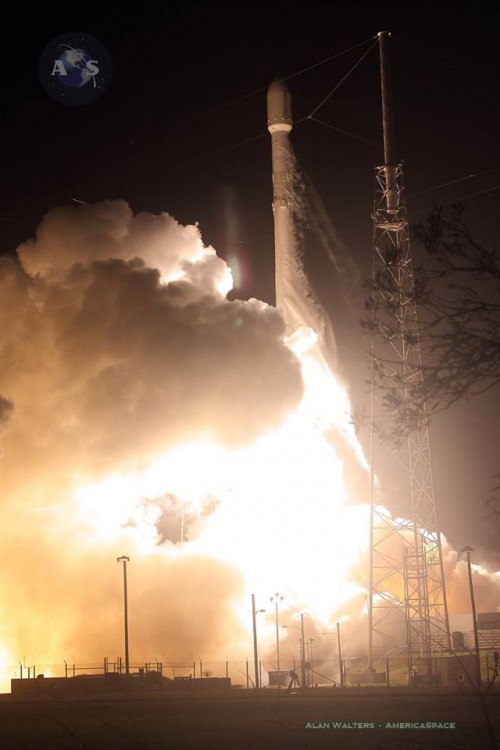
In readiness for Monday’s opening launch attempt, despite overcast skies and scattered showers in the morning, the Falcon 9 was fueled with a highly refined form of rocket-grade kerosene, known as “RP-1”, and densified (“deep cryo”) liquid oxygen. The cryogenic nature of the oxygen—whose liquid state exists within a range from -221.54 degrees Celsius (-368.77 degrees Fahrenheit) to -182.96 degrees Celsius (-297.33 degrees Fahrenheit)—requires the fuel lines of the engines to be chilled, in order to avoid thermally shocking and potentially fracturing them. “With the new propellant comes a new fueling regime,” explained AmericaSpace’s Launch Tracker at 6:15 p.m. EST. “Normally, by now fueling would be well underway with the rocket tanks full some two hours before launch. SpaceX are now fueling just under 35 minutes before launch time.” Right on cue, fueling got underway at 7:59 p.m. EST, as liquid oxygen began flowing into the booster, chilled to a level much closer to its freezing point than earlier Falcon 9 vehicles.
The excitement was palpable. “Really hard to get other work done while our rocket is about to launch,” tweeted former NASA astronaut Garrett Reisman, who now serves as SpaceX’s Director of Crew Operations. Added Canadian Space Agency (CSA) astronaut Jeremy Hansen: “You don’t normally see “landing” as part of rocket launch timeline. Will be incredible if @SpaceX pulls it off!”
At 8:16 p.m. EST the countdown reached its final “Go/No-Go” polling point of all stations at T-13 minutes. Passing through the final poll of flight controllers, the Terminal Countdown got underway at T-10 minutes. During this period, the Merlin 1D+ engines were chilled, ahead of their ignition sequence. All external power utilities from the Ground Support Equipment (GSE) were disconnected from the stack, the OG-2 payloads were placed onto internal power and at 8:24 p.m., the roughly 90-second process of retracting the “strongback” from the vehicle got underway. The Flight Termination System (FTS)—which is tasked with destroying the Falcon 9 v1.1 in the event of a major accident during ascent—was placed onto internal power and armed. Fueling concluded and the first stage’s propellant tanks attained flight pressure. The Merlin 1D+ engines were purged with gaseous nitrogen, and, at T-60 seconds, the SLC-40 complex’s “Niagara” deluge system of 53 nozzles were activated, flooding the pad surface and flame trench with 30,000 gallons (113,500 liters) of water per minute to suppress acoustic energy radiating from the engine exhausts.
At T-3 seconds, the nine upgraded Merlins roared to life, ramping up to a combined thrust of 1.5 million pounds (680,000 kg). This represents a significantly enhanced propulsive yield over the 1.3 million pounds (590,000 kg) pumped out by the earlier Falcon 9 v1.1 at the instant of liftoff. Following computer-commanded health checks, the stack was released from SLC-40 at 8:29 p.m. Immediately after clearing the tower, the booster executed a combined pitch, roll, and yaw program maneuver, establishing itself onto the proper flight azimuth to inject its 11 OG-2 passengers into low-Earth orbit. Eighty seconds into the uphill climb, the vehicle exceeded the speed of sound and experienced a period of maximum aerodynamic duress—colloquially dubbed “Max Q”—on its airframe.
At about this time, the Merlin 1D+ Vacuum engine of the second stage underwent a chill-down protocol, ahead of its own ignition later in the ascent. Later, two of the first-stage engines throttled back, under computer command, in order to reduce the rate of acceleration at the point of Main Engine Cutoff (MECO). Finally, at T+2 minutes and 58 seconds, the seven remaining engines shut down and, a few seconds later, the first stage separated from the rapidly ascending stack. The turn then came for the restartable second stage, whose Merlin 1D+ Vacuum engine came to life to continue the boost into orbit. According to SpaceX’s OG-2 press kit, the 11 satellites were expected to be deployed from their ESPA rings during a five-minute period from 15-20 minutes after leaving the Cape. At 8:54:07 p.m. EST, some 25 minutes after launch, all 11 satellites had successfully separated and begun their missions.
However, the successful delivery of the OG-2 payloads—affixed to three tiers of Moog, Inc.-built Evolved Expendable Launch Vehicle (EELV) Secondary Payload Adapter (ESPA) “rings” and marking SpaceX’s largest haul of spacecraft ever deployed in a single launch—was not the only major milestone expected to be accomplished in today’s mission. As described by AmericaSpace Managing Editor Mike Killian in a recent article, Sunday’s launch was see the Falcon 9 first-stage hardware propulsively return from the edge of space and alight on solid ground, out at the Cape’s Landing Complex (LC)-1. The latter was actually the historic Launch Complex (LC)-13, utilized for Atlas launches between 1958 and 1978, but unused for more than three decades, before SpaceX signed a five-year lease with the Air Force in February 2015. The new complex consists of a “primary” landing pad, measuring 200 x 200 feet (60 x 60 meters), and four “backup” pads, of slightly smaller dimensions at 150 x 150 feet (45 x 45 meters), the latter of which will be utilized in the event of last-second navigational and diversion changes to the descent profile.
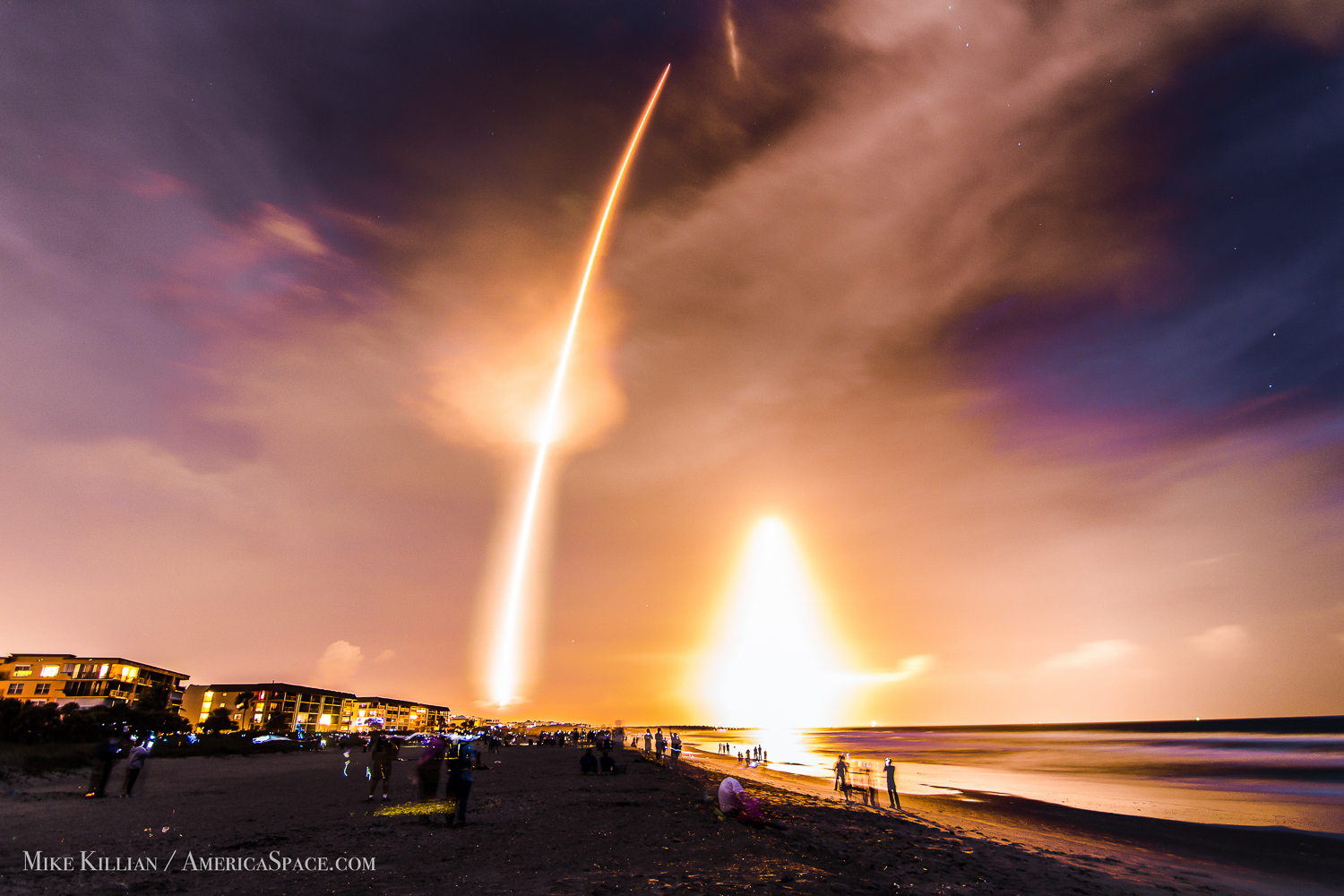
Accordingly, a huge area from north of Titusville to almost Miami, as well as large swathes of Florida’s Atlantic coastline, was closed to air traffic for about two hours surrounding T-0. SpaceX advised communities on Florida’s Space Coast of the possibility of a sonic boom—unheard from a returning space vehicle since the final descent of Atlantis at the close of the shuttle era on 21 July 2011—as the Falcon 9 first stage plunged back to Earth. After separating from the rest of the stack, about three minutes into the flight, the 150-foot-tall (46-meter) first stage was traveling at a velocity of 2,900 mph (4,670 km/h) and maintaining stabilization in these conditions has been likened to balancing a rubber broomstick in the palm of the hand, whilst in the midst of a fierce wind storm.
Three Merlin 1D+ “burns” were required to steadily reduce the first stage velocity and achieve stabilization for a controlled descent. An initial “Boost-Back” burn at T+4 minutes adjusted the vehicle’s impact point, pushing it upward and directing it back toward the Cape. Assisted by nitrogen thrusters, the stage flipped over and a “Supersonic Retro-Propulsion” burn at T+8 minutes slowed it to about 560 mph (900 km/h). A final “Landing” burn reduced this still further to just 4.5 mph (7.2 km/h). The first stage utilized compressed helium to deploy its four extendable landing legs and a quartet of lattice-like hypersonic grid fins—configured in an “X-wing” layout—were unfurled to control the lift vector. “Right now there’s a rocket maneuvering to try & land back at Cape Canaveral, for the 1st time ever,” tweeted Canadian astronaut Chris Hadfield. “Worth watching.”
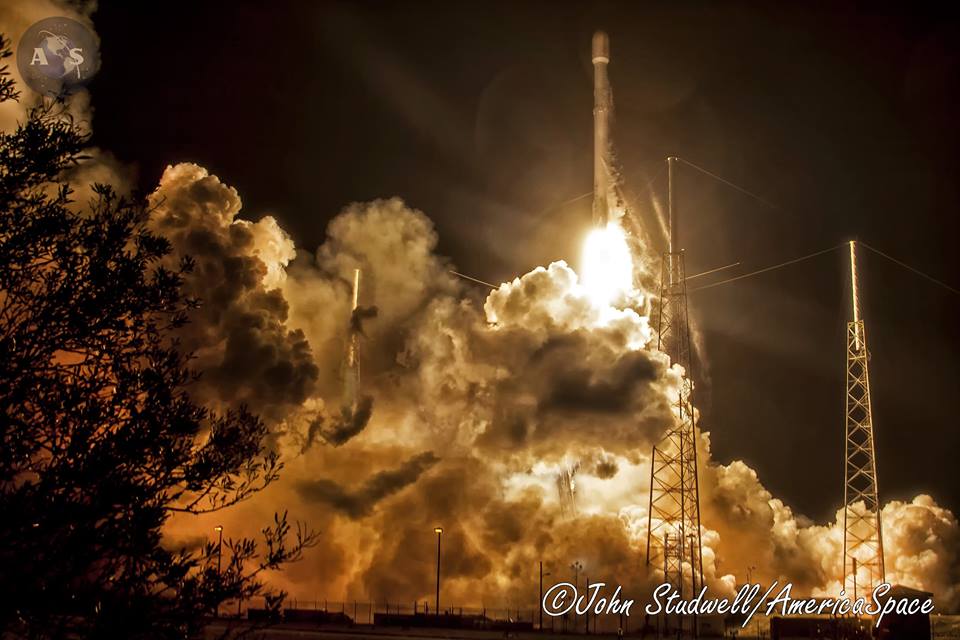
Coupled with engine gimbaling, these enabled a precision touchdown on the LC-1 surface, about 10 minutes after leaving SLC-40. Initial attempts to soft-land first-stage hardware on the Autonomous Spaceport Drone Ship (ASDS) in the Atlantic Ocean on two occasions, earlier in 2015, were partially successful, hitting their target, but ultimately topping over and exploding, due to the premature exhaustion of hydraulic fluid in the grid fins in the first instance and suffering excessive lateral velocity in the final seconds of descent in the second case. Providing backup support for today’s launch, the ASDS, dubbed “Of Course I Still Love You,” was deployed out of Port of Jacksonville by the Elsbeth III tug last week.
As circumstances transpired, the ASDS was unneeded and—against so many odds and to screams of “USA, USA” from the gathered crowds—SpaceX achieved a precision landing. “The Falcon 9 first stage landing is confirmed,” SpaceX tweeted as the booster blazed through the night and alighted perfectly on the ground at 10 minutes and 4 seconds after liftoff. The congratulations echoed around the world in the minutes after the successful landing, even as the OG-2 payloads were in the process of being deployed. As excited as a CEO could be to see his company’s satellites in orbit, Marc Eisenberg tweeted simply: “Bullseye!” Others followed with their praise. “Congratulations & Kudos @SpaceX,” tweeted German astronaut Alexander Gerst. “That was a hard landing to stick,” added Chris Hadfield. “Opens a brand new door to space travel.
Be sure to “Like” AmericaSpace on Facebook and follow us on Twitter: @AmericaSpace
.
Missions » Commercial Space » ORBCOMM » Missions » Commercial Space » ORBCOMM » SpaceX OG2 M1 » Missions » Commercial Space » ORBCOMM » SpaceX OG2 M2 »




Great landing!
What will be learned from tearing apart the engines and closely inspecting the first stage to reduce risks and make improvements for future flights are some of the important opportunities opened up by this landing and also Blue Origin’s New Shepard launch vehicle’s recent successful landing.
Risk reduction and significantly improving the mean time before failure of the many parts of spaceships are critically important.
Learning how to build extremely reliable reusable spaceships is essential for developing LEO, the Moon, the rest of cislunar space, Mars, and Ceres.
And repeatedly practicing the gentle landing of large rockets allows us to maintain and improve an essential do or die skill for future human missions to the Moon, Mars, and elsewhere.
Excellent work SpaceX!
That was an awsome launch and landing of the 1st stage. They are doing what others said couldn’t be done.
“Having suffered the catastrophic loss of a Falcon 9 v1.1 booster during first-stage flight on 28 June—”…Its hard to believe that SpaceX is the same company that launched both of these rockets…
They have just changed the world … Opening a door that others will soon follow. But first for those who know more…How long will it take to determine Booster Condition of the returned rocket? Musk has said that they will complete a Static Fire test on this rocket but not return it to service. Why not? Shouldn’t he rush to this option and scope up the Market…
The market for used orbital boosters is pretty non-existent at the moment. One must make a market for this sort of thing. And to do this SpaceX needs to verify the intergrity of the stage after landing. I suspect this requires a teardown that is not econimical or feasible to reverse. Better to learn everything you can about this stage and apply to new iterations; re-fly somthing you have some engineering confidence in.
I agree mostly, but I need to correct comething: There is no market for ANY kind of boosters. What customers buy is a launch service, not a booster/rocket.
So once they are satisfied that it can be reflown, it will be. But additional tweaks to the design may be necessary first as a result of examining this returned stage.
I agree. Sorry, I was implying launch service employing re-used booster.
“Musk has said that they will complete a Static Fire test on this rocket but not return it to service. Why not?”
According to Musk:
“So I think we’ll probably keep this one on the ground and just confirm through tests that it could fly again and then put it somewhere to display, because it’s quite unique. I think we’ll end up re-flying one of the subsequent boosters. We have quite a big flight manifest and should be doing well over a dozen flights next year. I think sometime next year we would aim to refly one the rocket boosters.”
SES has said they are interested in seeing one of their satellites being launched by a recovered rocket stage. If SpaceX successfully recovers the first stage from the SES-9 launch, I would expect to see that stage being flown again to launch SES-10.
Well …that didn’t take long …I suppose they want a big discount on the launch fee!
Sci-fi inspires us and makes us do things that only seemed impossible a short time ago. SpaceX is paving the way. I cant wait to hear how the booster survived the ordeal of launch and how much refurbishing it will take to go again. These are learning events.
So now that SpaceX has landed its Booster….Its time for Lockeed Martin to take the VentureStar out of cold storage or have they just sent that and the X-33 to the Black Budget..All the technology is there…Or perhaps another startup will acquire the rights and create a SSTO fleet…By the way …Grumman perfected the fabrication process for the composite LOX tanks in 2004…
Tracy the Troll –
From ‘Single stage to orbit mass budgets derived from propellant density and specific impulse’ By John C. Whitehead Lawrence Livermore National Laboratory June 6, 1996, we learn,
“Based on historically-proven launch vehicle hardware, liquid oxygen and kerosene appear to be a preferred propellant combination for SSTO. Of all the propellants considered, these require the smallest fraction of orbiting mass for major propulsion components.”
Yep, a single stage to orbit (SSTO) kerolox powered vehicle would be interesting.
However, if I had my druthers, an almost single stage kerolox vehicle that has large reusable solid propellant ‘zero stage’ boosters might be even much more interesting.
What would such a vehicle look like? Imagine an elongated and composite version of the first stage of the 3.9 meters in diameter Antares launcher sitting between two SRBs with each SRB being 3.7 meters in diameter and similar to those that will be used on the SLS.
Why reusable SRBs?
From: ‘Reusable Solid Rocket Motor—Accomplishments, Lessons, and a Culture of Success’ by Dennis R. Moore and Willie J. (Jack) Phelps Marshall Space Flight Center, we read,
“The postflight analysis and inspections provided invaluable reliability data as it enables observation of actual flight performance, most of which would not be available if the motors were not recovered.’ See:http://ntrs.nasa.gov/archive/nasa/casi.ntrs.nasa.gov/20120001536.pdf
Use Syntin or RP-2 instead of RP-1 for the RD-181 rocket engines. Why? Syntin has a “higher density, lower viscosity and higher specific heat of oxidation” according to ‘Syntin’ at Wikipedia. RP-2 has an even lower sulfur content than RP-1 and sulfur impurities are one of the main causes of coking.